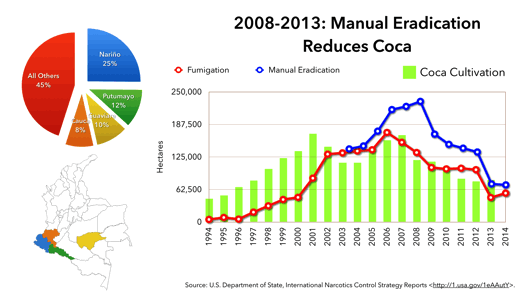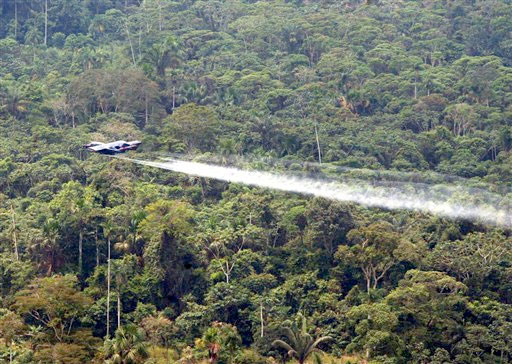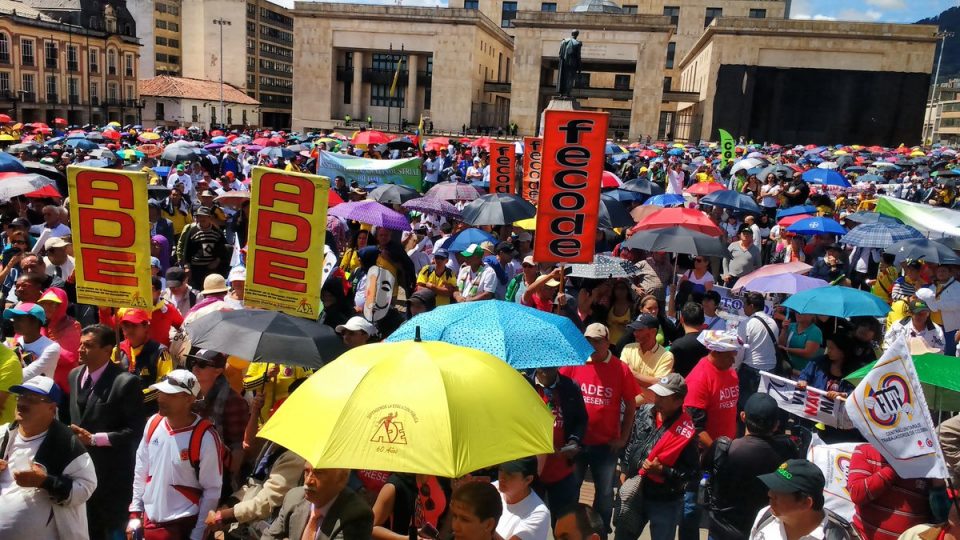Colombia made the right decision to stop dropping a potentially carcinogenic herbicide on isolated rural communities that grow coca in order to survive, argues analyst Adam Isacson
Ending Colombia’s aerial herbicide fumigation programme was a long-overdue step. Since 1998, I have travelled to several areas where spraying takes place (Guaviare, Putumayo, Nariño, Chocó) and talked to people on the receiving end of this strategy.
Everywhere I went, people – government and church leaders, campesinos – would tell me similar stories. We came to this remote jungle area, they would say, fleeing violence or trying to make a living. The government didn’t follow us here, and we’re cut off from the country’s civic and economic life. We grew legal crops, but the cost of producing and transporting them exceeded the market rate. Coca solved that problem, barely taking us out of poverty.
Then the government – whose civilian representatives we never see here – flew over our farms spraying herbicides. They destroyed everything, including our food. We felt ill, some said. We’re hungrier now, they told me. We feel even more abandoned and betrayed by our government, nearly all said.
I’ve opposed the fumigation policy not only because I feel ashamed that my government supported a policy that’s cruel, but also because it weakens the Colombian government’s legitimacy in guerrilla-controlled zones. I also opposed it because it hasn’t worked. Fumigation can reduce coca-growing in specific areas for a limited amount of time. If the state remains absent, growers quickly adapt their methods, as they did between 2004 and 2007 when – despite record levels of fumigation – the amount of coca detected in Colombia stubbornly increased.
Coca-growing started to wane after 2007, a period of reduced fumigation, increased manual eradication, and upped efforts to establish state presence on the ground in coca-growing zones. Coca crops were on the rise again in 2014, for the first time in seven years, mainly as both fumigation and manual eradication dropped sharply after 2012. Nothing filled the vacuum.
Over the years, I heard health claims that were hard to evaluate. Campesinos complained of gastrointestinal, respiratory, and skin inflammations. Studies pointed to eye damage, placental damage, miscarriages, and danger posed to aquatic life. However, I am not a scientist and couldn’t evaluate these claims on my own. To some extent, it didn’t matter: people in fumigation zones strongly believed that their government was poisoning them, which of course makes “winning hearts and minds” terribly hard in vast ungoverned parts of the country.
Though I had not heard earlier of a possible link to cancer, the World Health Organization (WHO) finding in March was alarming because of the very high credibility both from the agency and the medical publication that published its study. The WHO finding left Colombia’s government with a stark choice: stop the program, or keep spraying a possible carcinogen over its own citizens. Colombia chose wisely.
The US government continues to dispute health and environmental claims. It also insists that aerial spraying is the most effective coca eradication method. It is also the safest for the eradicators, who never have to touch the ground. But with over 16 hectares sprayed for every hectare eradicated, it is not particularly effective. Still, officials such as US Ambassador Kevin Whitaker have sent the right message: Colombia’s sovereign decision will not affect the bilateral relationship.
In a few years, though, the US government will be well-placed to say “we told you so” if Colombia fails to do anything new in previously sprayed coca-growing zones, such as establish a basic government presence. If these communities remain abandoned, suspending fumigation will lead to more coca cultivation. That would be a terrible outcome.
The alternative is already spelled out in the agreement on illicit crop reduction between the Colombian government and the FARC delegations in Havana, Cuba, signed in May 2014. Colombia has committed itself to signing “Integral Substitution and Alternative Development” agreements with coca-growing communities, promising food security, productive, and similar assistance to all who stop cultivating the crop. Those who cheat on such agreements will see their coca forcibly removed by teams of manual eradicators, with ex-FARC to serve as likely enforcers.
Related: Cacao for Coca replacement scheme in Colombia
This – governance in long-abandoned areas – is the way forward, not a new spray programme which boasts a new chemical. As fumigation is to be suspended by October this year, the government should begin pursuing these voluntary eradication agreements now, wherever security conditions permit. If the government-FARC peace talks continue to make progress toward de-escalation of the conflict, we can expect to see security conditions improve in more areas.
Adam Isacson is a Senior Associate for Regional Security Policy at the US think tank Washington Office on Latin America (WOLA).
In context: CocaGreg Haugan Colombia has long been associated with cocaine. However, before the 1990s this mostly consisted of processing and trafficking, not crop cultivation. Coca growing began expanding rapidly in the mid-1990s, leading to the joint formation of Plan Colombia by the United States and Colombia in 1999. Between 2000 and 2008, the United States spent nearly US$470 million per year on subsidies to combat drug production and trafficking in Colombia. This added to Colombia’s annual spending of approximately US$710 million. While over a billion dollars was being spent on these programmes (approximately 1.1% of Colombia’s GDP), Colombia continued producing approximately 65% of the cocaine consumed worldwide, generating US$7.8 billion in revenues and constituting the main source of funding for illegal armed groups. A significant portion of Plan Colombia spending has been assigned to aerial spraying programmes. Approximately 128,000 hectares of land have been subject to aerial fumigation annually over the past decade. Glyphosate is the main ingredient in aerial fumigations, often conducted by American contractors such as DynCorp, dispersing herbicides developed by companies such as Monsanto. Glyphosate has long been suspected of being harmful to human health, leading to a diplomatic dispute between Ecuador and Colombia. In 2008 Colombia announced that it would cease spraying in areas within 10km of the Ecuadorean border. Two studies by Daniel Mejia, director of the Center for Studies on Security and Drugs at the Universidad de Los Andes, have sought to change the discourse on fumigation policy in Colombia. With Mejia also serving as president of the government’s Drug Policy Commission under the Ministry of Justice and the Ministry of Health, these studies are at the forefront of the current debate. One study shows that an increase in aerial spraying increases an individual’s probability of visiting the doctor for dermatological problems and significantly increases the probability of women having a miscarriage. A second study estimates that aerial fumigation reduced the area under coca cultivation by 20%-35%. In a recent interview, Mejia suggested that this impact is small when compared against the cost of aerial fumigation, while other programmes, such as manual eradication and crop substitution, might be more effective and resolve the health concerns surrounding aerial fumigation.  2008-2013: Manual Eradication Reduces Coca. Source: US Department of State, International Narcotics Control Strategy Reports. |
The Opinion section is a space for your views and opinions. We’ve featured articles on all aspects of life in Colombia – from the free trade agreement to bull fighting.Whether you agree or disagree with anything we’ve written, we’d love to hear your thoughts – leave a comment below, tweet us at @bogotapost, post on our Facebook page /BogotaPost or email us at [email protected].The articles in ‘Opinion’ are commentary, not news reporting. The views expressed in this section are those of the author and do not necessarily reflect those of The Bogota Post or its publishers. The publishers take no responsibility for the accuracy of any information published in this section. |






